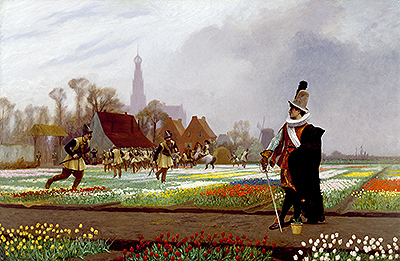Jean-Leon Gerome is a French Orientalist painter and The Tulip of Fully is one of his many paintings that he painted in the year 1882.
The painting is a depiction of the craze for tulips or otherwise known as tulipomania. This craze for tulips had at that time swept the whole of Netherlands during the 17th century. Tulips had grown to be a very precious commodity in the region.
Setting and Location
The painter created this artistic impression of the time when prices for tulips have soared by great margins and every kind of investor tried as much as possible to cash in on the craze. In the foreground, a viewer can immediately notice a Dutch soldier standing with a sword and a bunch of them trampling over the fields in the middle ground. This was in a bid to try and stabilise the supply of tulips and prevent the bubble that had wrecked the economy from popping.
Techniques and Approaches
Just like many other of his paintings, this was particular painting is vaguely romantic and superbly realistic. His brushworks that were especially inspired by Orientalism played an instrumental role in depicting the extent of economic distress that led to a great crash to the stock market. The artist vividly depicted the follies to which the effect of modern capitalism could have the ability to drive people that could otherwise be rational.
Inspiration and Influences
He was able to build his career on subjects from the Middle East and antiquity and Orientalism played a vital role in shaping his painting approaches. Apart from Orientalism, other noteworthy names in the art industry also left a mark on the artist's career. An analysis of some his works and you would immediately notice that some of these artists including Frédéric Auguste Bartholdi and Jean-Auguste-Dominique Ingres.
To date, his contributions to the art industry are still felt. He had a successfully live through his career as a successful Orientalist and for that reason he was a source of inspiration ad influence on many other artists including Jon Swihart, Jean-Paul Laurens and Henri Rousseau among other notable names. His techniques continue to influence artists to date.




